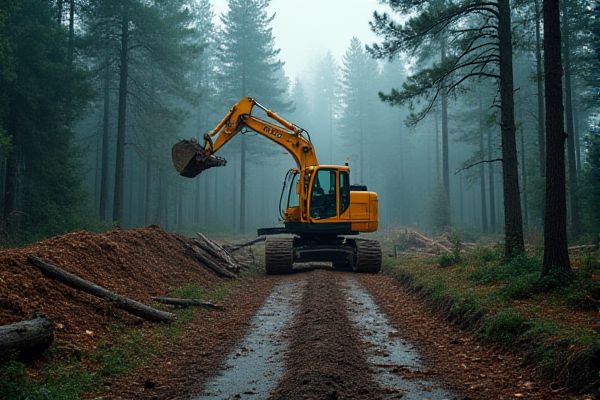
AI is transforming the timber industry through advanced technologies that optimize production processes. Machine learning algorithms analyze data from timber harvests, enabling more accurate forecasting of yield and quality. Drones equipped with AI can assess forest health, while automated sawmills enhance cutting precision, reducing waste. Predictive maintenance powered by AI minimizes machinery downtime, ensuring smoother operations and increased profitability.
AI usage in timber industry
Predictive maintenance.
Predictive maintenance in the timber industry can significantly reduce downtime and improve operational efficiency. By analyzing data from machinery, companies like Stora Enso can identify potential failures before they occur. This proactive approach allows for timely repairs, minimizing disruption and saving costs. The use of AI can lead to better resource allocation and enhance overall productivity in timber processing operations.
Forest inventory management.
AI can enhance forest inventory management by enabling more accurate data collection and analysis. For instance, leveraging machine learning algorithms can optimize the assessment of tree growth and health, which can improve resource allocation. Predictive analytics can also forecast timber yields, potentially increasing profitability for companies like Weyerhaeuser. The integration of remote sensing technologies further allows for real-time monitoring of forest conditions, enhancing decision-making processes.
Supply chain optimization.
AI in the timber industry can enhance supply chain optimization by predicting demand patterns and improving inventory management. For example, companies like West Fraser Timber Co. utilize AI algorithms to streamline logistics and reduce waste. The possibility of integrating machine learning models could lead to significant cost reductions and efficiency gains. This can provide a competitive edge in an industry often challenged by fluctuating market demands.
Automated quality control.
AI usage in the timber industry can lead to improved efficiency in automated quality control processes. For example, systems can analyze wood grain patterns and detect defects more accurately than human inspectors. This technology has the potential to reduce waste by ensuring only the highest quality timber is processed. Implementing AI can create significant cost savings for companies like TimberTech while enhancing product consistency.
Carbon footprint analysis.
AI can optimize timber production processes, potentially reducing waste and improving efficiency. By analyzing carbon footprint data, companies can identify areas for reducing emissions, enhancing sustainability efforts. For instance, the Forest Stewardship Council can use AI-driven insights to promote eco-friendly practices among certified organizations. This approach may lead to increased marketability and consumer preference for sustainably sourced timber products.
Smart forestry equipment.
AI technology can enhance efficiency in the timber industry by optimizing resource management and reducing waste through precise data analysis. Smart forestry equipment, such as drones and automated machinery, allows for better monitoring of forest health and inventory management. Implementing these advancements can lead to increased productivity and sustainability practices, benefiting companies like Weyerhaeuser. The potential for improved decision-making processes can significantly affect overall profitability in this sector.
Harvest prediction models.
AI usage in the timber industry can enhance harvest prediction models, leading to more efficient resource management. By analyzing historical growth data and environmental factors, these models can provide accurate forecasts of timber yield. Companies like GreenTree Solutions are utilizing machine learning to optimize their logging operations. This approach could potentially reduce waste and improve overall profitability for stakeholders.
Species classification.
AI has the potential to enhance species classification in the timber industry by analyzing characteristics of various wood species. Machine learning algorithms can be trained on datasets containing images and physical properties of timber to improve accuracy in identification. Companies like International Wood Products have already begun implementing such technologies to streamline their operations. This approach can lead to better resource management and sustainability practices within the industry.
Yield optimization algorithms.
Yield optimization algorithms can significantly enhance efficiency in the timber industry by predicting the best way to process logs for maximum output. For example, companies like Weyerhaeuser have begun implementing these technologies to reduce waste and improve profitability. The algorithms analyze various factors such as log dimensions and species, which increases the chance of achieving higher quality lumber. Implementing such advanced analytics could lead to cost savings and a competitive advantage in the market.
Remote sensing and monitoring.
AI can enhance efficiency in the timber industry by analyzing data from remote sensing technologies, like satellite imagery. This can enable precise monitoring of forest health and growth patterns, which may lead to improved management practices. Companies such as Timberland can leverage these insights to optimize resource allocation and reduce waste. The potential for increased sustainability and productivity makes this application of AI a valuable consideration for stakeholders in forestry.
 techknowy.com
techknowy.com